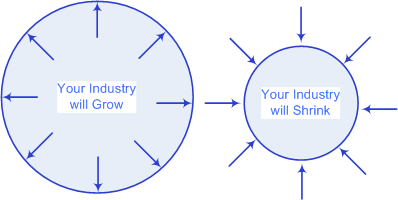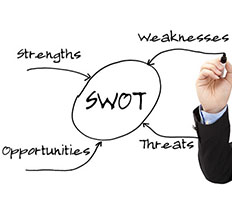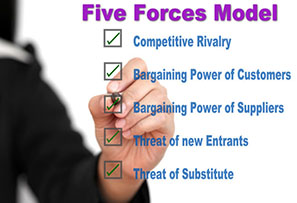The Macro Environment Analysis is the first step of a strategic analysis which in turn kicks off the traditional; strategic planning cycle; it is sometimes referred to as an external analysis, a pest analysis or a pestle analysis.

The purpose of the Macro Environment Analysis is to identify possible opportunities and threats that will impact on your industry as a whole and that are outside the control of your industry.
The goal of completing a macro environment analyses is to answer the following questions
- What environmental factors will affect the growth of our industry as a whole?
- What is the likely cumulative impact of all of the things that affect the growth of our industry i.e. will our industry grow or shrink over the next 3-15 years?

Note: During your macro environment analysis you will be forecasting possible trends based on what you currently know about your environment, such as “interest rates will remain low for the next three years”. However, you will not always be correct as you are forecasting based only on what you currently know.
Analysis example: An aging population is a demographic or social trend in many western counties which when combined with the trend of people living longer is resulting in an increase in the total number of retired persons. Retired persons are the largest segment who buys caravans.
This trend should result in an increase in the total number of caravans sold – so if you are in the caravan industry based on this one trend you should expect to see growth in the total size of your industry.
In the macro environment analysis your identified opportunities and threats may affect many industries, for example: a possible interest rate rise will affect the amount of disposable income people have.
A reduction in disposable income could affect the travel industry, pubs and clubs, moviegoers, restaurants, clothing, kids birthday party venues and the building and renovation industries alike.
However only industries impacted by an increase in interest rates should consider it in their analysis.
For Example: If you are in the greeting card industry and fluctuations in interest rates will not affect the size of your industry then you do not need to consider interest rates in your macro environment analysis. (However if you are heavily geared or have large borrowings you will need to consider the impact of interest rates in your internal analysis)
Strategic Leadership and the Macro Environment Analysis
Once you have grasped an understanding of the macro environmental analysis you will be continually scanning for information about macro factors activities such as watching or reading the news, reading management magazines and when in conversation with other industry leaders will all lead to a greater understanding of the macro environment.
In addition there are a number of things you can do to improve the depth of your understanding of the macro environment.
- Networking with senior leaders in your industry
- Networking with political parities
- Source strategic analysis information prepared for your industry typically by a third party provider (Normally through subscription)
- Read the financial papers
- Read management magazines
- Surf the Web for trends
Note: Large organisations in industries with heavy legislative compliance responsibilities such as banking and finance will often have an employee whose sole role is to research the government’s future legislative changes and assess the impact on their business even before the legislation is passed.
How to do a Macro Environment Analysis
A macro environmental analysis can be completed by yourself or in a brainstorming session, however you will need to do some research before starting your analysis.
To simplify the Macro Environment Analysis the following 6 broad heading will provide some structure, a good start is to list all of the trends you can think of or can find and indicate whether they will have a positive impact or negative impact on the size of your industry.
- Download your free strategic planning template for the Macro Environment Analysis
- Political: The macro political environment analysis will identify changes in the position politicians take on issues. A current example is a shift towards greener policies in the developed world. If an election is approaching you may look at the variation in policies from each party and assess the impacts on your industry of each parties viewpoint
- Economic Trends: The macro economic environment analysis will identify trends such as changes in personal disposable income, interest rates, inflation, exchange rates and unemployment rates.
- Social/Cultural Trends: The macro social/cultural environment analysis will identify trends in societies beliefs, behaviours, values and norms. Such as the number of part time workers, attitudes towards global warming, make up of the family structure as well as trends in population growth at relevant ages for your industry (There maybe zero population growth in general but high growth in the number of people over 65). The population may also shift from rural to cities or visa versa.
- Technological Trends: The macro technological environment analysis will identify changes in the application of technology and uptake of technology. A current example is a shift towards online transactions and in some areas a shift away from online transactions.
- Legal Trends: The macro legal environment analysis is closely linked to the political environment (politicians tend to make the laws), but also includes trends in court decisions such as liability compensation. Most organisations need to be constantly aware of changes in labour laws.
An Example: Legal changes that resulted from the rise of uber has seen the value of taxi plates decline significantly in some countries. - Environmental: The macro environment analysis will identify how changes in the environment will impact on your industry.
The final step of the macro environmental analysis is to summarize the identified opportunities and threats and determine if you should expect growth, stability or decline in the size of your industry.
For example the increase in retired persons should result in the caravan industry growing in size, however a drop in share values will see retired people with less disposable income. In this scenario you need to determine which trend will have the largest impact.
You may find that you discover some trends with the potential to have a significant impact on your industry such as an interest rate rise may cause a drop in demand for the building industry. Even if you forecast interest rates to remain low you should scenario planning or contingency planning just in case something unexpected happens to interest rates and then keep a close watchful eye on the progress of the trend.
Knowledge for the good leader: Pest analysis and Pestle analysis
These two have only been included so that if anyone asks you if you know how to do a pest analysis you will know that is has nothing to do with mice, cockroaches or ants.
The P.E.S.T. analysis is the same as the macro environment analysis but used the acronym P.E.S.T. to help you remember the headings
- Political
- Economic
- Social/cultural
- Technological
And the P.E.S.T.L.E Analysis is same as the macro environment analysis but used the acronym P.E.S.T.L.E. to help you remember the headings
- Political
- Economic
- Social/cultural
- Technological
- Legal
- Environmental (Environmental issues, global warming, pollution etcetera)








